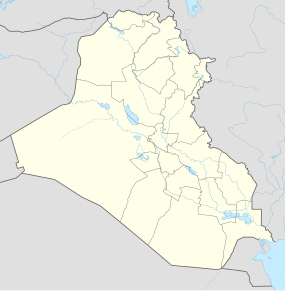Ctesiphon

Map of Seleucia-Ctesiphon in the Sassanid era
|
|
| Location | Salman Pak, Baghdad Governorate, Iraq |
|---|---|
| Region | Mesopotamia |
| Coordinates | 33°5′37″N 44°34′50″E / 33.09361°N 44.58056°ECoordinates: 33°5′37″N 44°34′50″E / 33.09361°N 44.58056°E |
| Type | Settlement |
| History | |
| Cultures | Iranian |
| Site notes | |
| Excavation dates | 1928–1929, 1931–1932, 1960s–1970s |
| Archaeologists | Oscar Reuther, Antonio Invernizzi, Giorgio Gullini |
| Condition | Ruined |
Ctesiphon (/ˈtɛsᵻfɒn/ TESIFON; Greek: Κτησιφῶν; from Parthian/Middle Persian: tyspwn or tysfwn) was an ancient city located on the eastern bank of Tigris, and about 35 kilometers south-east of present day Baghdad. It became the capital of Persia during the Parthian empire, in about 58 BC, and remained the capital of the Sasanian Empire until the Muslim conquest of Persia in 651 AD.
Ctesiphon developed into a rich commercial metropolis, merging with the surrounding cities along both shores of the river, including the Hellenistic city of Seleucia. Ctesiphon and its environs were therefore sometimes referred to as "the cities" (Aramaic: Mahuza, Arabic: المدائن, Al-Mada'in). In the late sixth and early seventh century, it was one of the largest cities in the world.
During the wars with the Roman empire Parthian Ctesiphon fell four times to the Romans, and later once in the Sasanian period. It was also the site of the Battle of Ctesiphon in which Julian the Apostate was killed in action. After the Muslim invasion the city fell into decay and was depopulated by the end of the 8th century. The most conspicuous structure remaining today is the great archway of Ctesiphon.
...
Wikipedia

